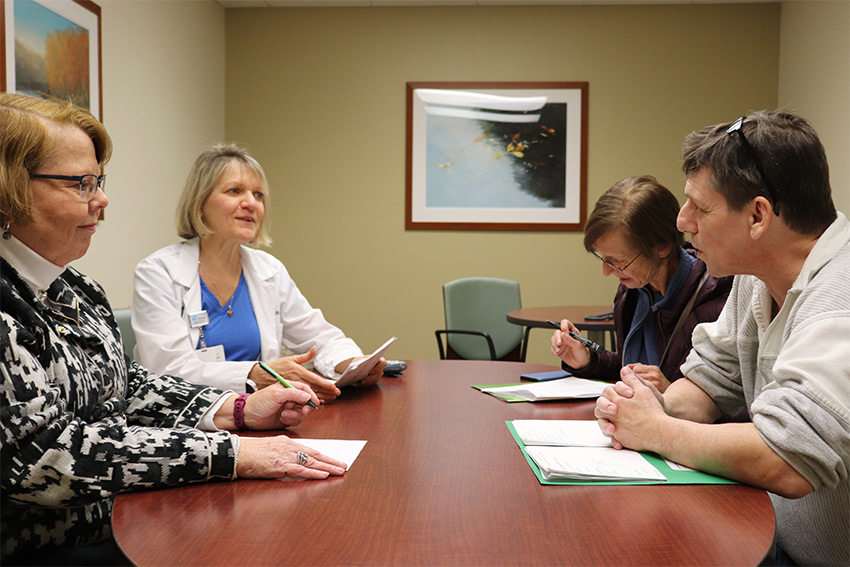Lung cancer clinic now open, navigator provides personalized care
April 26, 2018

As part of NCH Cancer Services, our new Lung Cancer Clinic has opened in Radiation Oncology, providing patients with comprehensive care through a team approach that takes patients from diagnosis to treatment to follow-up visits. Close to 150 lung cancer patients were treated at NCH in 2016 and 490 lung cancer screenings were performed in 2017.
Following a review, a newly diagnosed lung cancer patient and his/her family is invited to the clinic where they meet with each member of the multidisciplinary lung cancer care team one-on-one in a single visit. A pulmonary physician may refer a patient after diagnosis, or a primary care physician may refer a patient after performing a chest x-ray that suggests an increased suspicion of cancer. Juli Aistars, Lung Cancer Patient Navigator, says, “It’s not just lung cancer but suspicious findings.”
Not every lung cancer patient is going to come to the clinic. The goal of the clinic is to help a patient see all of the doctors at once to get their treatment plan or their next steps.
“We’re saving them time and saving them from having to make all of these different appointments,” Aistars says. “It’s for the benefit of the patient.”
Patients are saved emotional stress because they’re moved into a treatment plan as fast as possible, which helps their outcome and peace of mind. Aistars helps patients with coordination of care, providing education and support and addressing their concerns. The patient meets with a medical oncologist, thoracic surgeon and radiation oncologist as needed at the clinic and social worker Kim Jensen is on hand to assist with psychosocial needs that may include counseling, community resources and financial assistance.
One example is a patient who exhibited shortness of breath.
“Kim taught her breathing exercises to help with her anxiety,” Aistars says. “She does a lot more than people realize.”
The team also addresses any barriers to care, such as insurance or traveling to the hospital for treatment. When patients leave the clinic, they have a treatment plan or a next step. They may have some necessary appointments scheduled, and they may hear back from the team for further evaluation and treatment.
“These are complicated cases,” says Aistars. “We review patient cases each week and make recommendations.”
Lung cancer diagnosis and treatment at NCH includes video-assisted thoracic surgery (VATS); robotic surgery using the daVinci Surgical System; pneumonectomy, lobectomy, segmentectomy; Cyberknife, and other leading-edge radiation therapies like IMRT and IGRT using image guidance, as well as chemotherapy and immunotherapy.
Diagnostic tests include low-dose CT scan, MRIs, positron emission tomography (PET) and CT-guided needle biopsies to help stage lung cancer. Interventional pulmonologists use electromagnetic navigational bronchoscopy and endobronchial ultrasound to biopsy lymph nodes and masses, often in hard-to-reach areas of the lungs.
Oncology physicians at NCH participate in various clinical trials involving chemotherapy, radiation and/or immunotherapy, and medical oncologists take part in many trials offering access to newer drugs. NCH is a member of NRG Oncology, a group under the National Cancer Institute.
A monthly support group for people directly affected by lung cancer is held at the hospital, and a smoking cessation program helps anyone who wants to quit, has already quit or is thinking about quitting.
NCH also follows patients through an Outpatient Pulmonary Rehabilitation Program which helps patients lower their complications through exercise, endurance training, lifestyle modifications and group and individual counseling.
“We really do have a fantastic program and we’re getting better and better,” Aistars says.
Note: There are 9 million people in the U.S. who are eligible for lung screening, but only about 2.5 percent are getting screened, according to Aistars, who read the statistic in a recent Chicago Tribune article.
“We need to make sure we are screening people who are eligible for lung screening,” she says. “It’s covered by insurance but there are still barriers to lung screening.”
The keys to improving patient outcomes include prevention, early detection, and a quick path to treatment following diagnosis.
“Every patient with suspicious findings for cancer or a new diagnosis of cancer should have access to a Patient Navigator,” Aistars says.